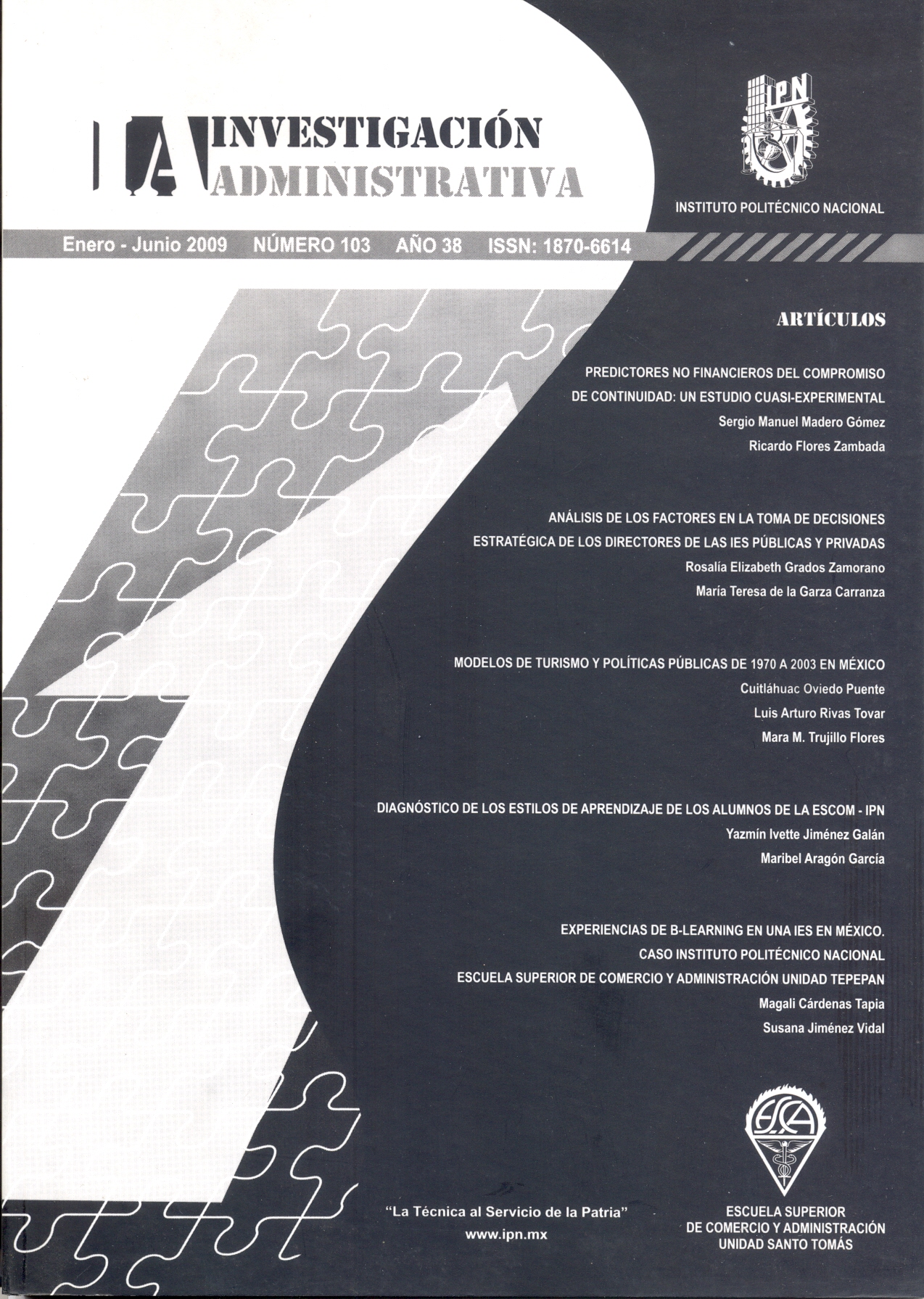Non-financial predictors of continuance commitment: a quasi-experimental study
Main Article Content
Abstract
The results, based on an experimental research in which 512 employees participated, show that organizational efforts to create an internal positive work environment and the existence of adequate working conditions to perform the task, becomes a critical requirement to get continuance commitment.
Asuperior external job offer reduces employee's continuance commitment, however this relationship is moderated by the internal work environment and working conditions. Gender, seniority, job position, marital status and educational level influence previous relationship.
Article Details

This work is licensed under a Creative Commons Attribution-NonCommercial 4.0 International License.
References
Allen, N. J. & Meyer, J. J. (1990a). The Measurement and Antecedents of Affective, Continuance and Normative Commitment to the Organization. Journal of Occupational Psychology, 63:1 -18.
Allen, N. J. & Meyer, J. J. (1990b). Organizational Socialization Tactics: A Longitudinal Analysis of Links to Newcomers' Commitment and Role Orientation. Academy of Management Journal. 33 (4) 847-858.
Bayona, C., Goñi, S. & Madorrán, C. (2000). Compromiso organizacional: implicaciones para la gestión estratégica de los recursos humanos. Obtenido el 2 de diciembre de 2008 de www.upna.es y de http://www.unavarra.es/organiza/gempresa/wkpaper/dt33-99.pdf
Becker, T, Billings, R., Eveleth, D. & Gilbert, N. (1996). Foci and Bases of Employee Commitment: Implications for Job Performance. Academy of Management Journal, 39 (2): 464-482
Berman, E., West, J. & Richter, M. (2002). Workplace Relations: Friendship Patterns and Consequences (According to Managers). Public Administration Review. 62 (2): 217-230
Broscio, M., & Scherer, J. (2003a). Building Job Security: Strategies for Becoming a Highly Valued Contributor. Journal of Healthcare Management, 48 (3): 147-151
Broscio, M. & Scherer, J. (2003b). Six Steps to Creating a Personal Career-Decision Framework. Journal of Healthcare Management, 48 (6): 355-361.
Carson, K., Carson, R, Roe, W., Birknmeier, B. & Phillips, J. (1999). Four Commitment Profiles and their Relationships to Empowerment, Service Recovery and Work Attitudes. Public Personnel Management, 28(1): 1-13
De Souza, G. (2002). A Study of the Influence of Promotions on Promotion Satisfaction and Expectations of Future Promotions among Managers. Human Resource Development Quarter/y, 13(3): 325-340.
Elvira, M. M. (2001). Pay me now or Pay me Later: Analyzing the Relationship between Bonus and Promotion Incentives. Work and Occupations, 28 (3): 346-370
Fairburn, J. A. & Malcomson, J. M. (2001). Performance, Promotion, and the Peter Principle. Review of Economic Studies, 68 (234): 45-66
Ferratt, T. W., Agarwal, R., Brown, C. V. & Moore, J. E. (2005). IT Human Resource Management Configurations and IT Turnover Theorical Synthesis and Empirical Analysis. Information Systems Research, 16(3): 237- 255.
Flores, R. & Castañeda, A. G. (2001). Dinámica del comportamiento del trabajador mexicano: un enfoque inductivo. Memorias del XII Congreso Nacional de Psicología del trabajo y IX Iberoamericano de Recursos Humanos. Acapulco, México.
Jaros, S. J. (1995). An Assessment of Meyer and Allen's (1991) Three-Component Model of Organizational Commitment and Turnover Intentions. Academy of Management Journal, 317-321.
Jaros, S. J., Jermier, J. M., Koehler, J. W. & Sincich, T. (1993). Effects of Continuance, Affective, and Moral Commitment on the Withdrawal Process: An Evaluation of eight Structural Equation Models. Academy of Management Journal, 36 (5): 951-995.
Leonard, N. H., Beauvais, L. L. & Scholl, R. W. (1999). Work Motivation: The Incorporation of Self-Concept-Based Processes. Human Relations, 52 (8): 969-998.
Lee, J. (2001). Leader-Member Exchange, Perceived Organizational Justice, and Cooperative Communication. Management Communication Quarterly: McQ, 14 (4): 574- 589.
Lee, J. (1998). Effective Maintenance Communication in Superior-Subordinate Relationships. Western Journal of Communication, 62 (2): 181-208
Littlewood, H. (2004). Análisis factorial confirmatorio y modelamiento de ecuación estructural de variables afectivas y cognitivas asociadas a la rotación de personal. Revista Interamericana de Psicología Ocupacional, 23 (1): 27-37.
Littlewood, H. (2003). Meta-análisis del apoyo organizacional percibido y compromiso organizational en organizaciones mexicanas. Revista Interamericana de Psicología Ocupacional, 22 (2): 45-56.
Madero, S. M. (2006). Sistemas de retribución variable: un estudio de la utilización de los bonos por desempeño en México. Tesis doctoral. Universidad de Deusto
McConnell, C. R. (1998). Lear what Motives your Employees: Look to Yourself. The Health Care Supervisor, 16 (4): 1 -11.
McConnell, C. R. (1997). Employee Recognition: A Little Oil on the Troubled Waters
of Change. The Health Care Supervisor, 15
(4): 83-90.
McShane, S. L. & Von Glinow, M. A. (2003). Organizational Behavior: Emerging Realities for the Workplace Revolution. 2a. ed., McGraw Hill. New York.
Meyer, J. R, Bobocel, R. & Allen, N. J. (1991). Development of Organizational Commitment During the First Year of Employment: A Longitudinal Study of Pre-and Post-Entry Influences. Journal of Management, 17 (4): 717-733.
Meyer, J. R, Irving, G. & Allen, N. J. (1998). Examination of the Combined Effects of Work Values and Early Work Experiences on Organizational Commitment. Journal of Organizational Behavior, 19(1): 29-52.
Meyer, J. R, Paunonen, S. V, Gellatly, I. R., Goffin, R. D. & Jackson, D. N. (1989). Organizational Commitment and Job Performance It's the Nature of the Commitment that Counts. Journal of Applied Psychology, 74 (1): 152-156
Moore, J. E. (1999). Are you Burning out Valuable Resources? HRMagazine, 44 (1): 93- 98.
Mowday, R. T, Porter, L. W. & Steers, R. M. (1982). Employee-organization linkages. Academic Press
Nielsen, I. K., Jex, S. M. &Adams, G. A. (2000). Development and Validation of Scores on a Two-Dimensional Workplace Friendship Scale. Educational and Psychological Measurement, 60 (4): 628-643.
Penley, L. E. & Gould, S. (1988). Etzioni's Model of Organizational Involvement: A Perspective for Understanding Commitment to Organizations. Journal of Organizational Behavior, 9(1): 43-59
Tremblay, M., Sire, B. & Balkin, D. B. (2000). The Role of Organizational Justice in Pay and Employee Benefit Satisfaction, and its Effects on Work Attitudes. Group & Organization Management, 25 (3): 269-290.
Von Bertrab, H. & De Marquez, V. B. (1979). Dinámica de la empresa mexicana: perspectivas políticas, económicas y sociales. Colegio de México, México, 435 pp
Wiener, Y. (1982). Commitment in Organizations: A Normative View. The Academy of Management Review, 7 (3): 418- 428.

